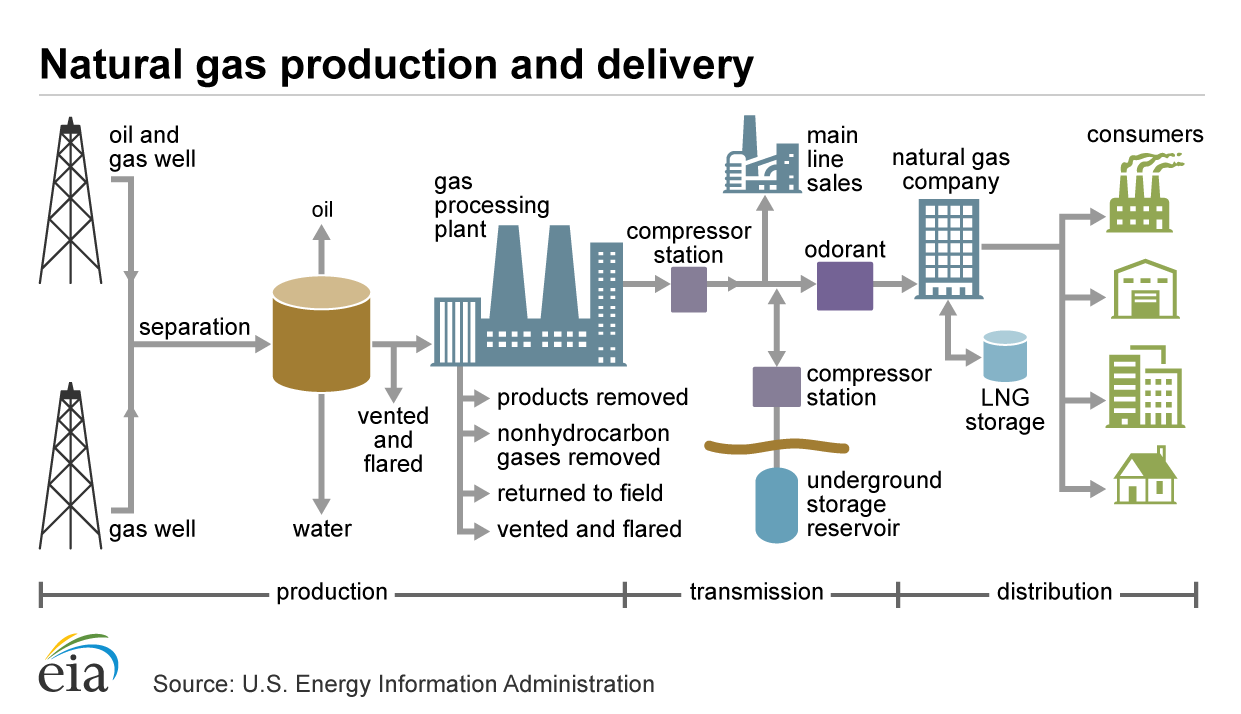Have you ever wondered how natural gas gets to your house?
By the time that little blue flame is lit on your stove, that natural gas has actually gone through several processes, and traveled hundreds of miles, to arrive at your property.
Read on to learn more about what makes modern natural gas transport safe and efficient.
Natural Gas: Origins and Extraction
Natural gas is created deep below the surface of the earth, as organic materials are compressed and made into coal, rock, and minerals.
Originally natural gas was entirely a by-product of crude oil, but today there are various methods of detecting it underground, where it’s trapped in cracks and pools in large reservoirs.
Engineers use special testing techniques to discover where there are large quantities, and use wells and pumps to draw it out with pressure.
A well will either be drilled vertically or horizontally. When a horizontal well is used in combination with pressure, water, sand, and chemicals, we call this process hydraulic fracturing, or “fracking.”
After it’s pulled from the earth, the natural gas gets to your house, eventually, via high-pressure systems that run through a series of pipelines.
Compressor Stations
After the gas is extracted from the source, it’s sent through steel pipelines.
A series of field compressors, located at stations about every 50 miles, is used to keep pressure high, as pressure naturally lowers while the gas travels away from its source.
While operators do work at these compressor stations, monitoring and adjusting gas transport for efficiency and safety, today they mostly run on automated systems.
These compressor stations can control and shut off gas as needed.
Gas here moves at speeds of about 30 mph and pressures of up to 1500 PSI. The pipes at this end are very large, built to withstand intense pressure, and carry large amounts of gas.
But the pipes eventually diverge into a series of branches as they move towards towns, cities, and your home.
The smaller the pipes get, the lower the pressure that pushes it forward. By the time the natural gas gets to your house, it’s typically only moving at a rate of about .25 PSI.
Processing and Transmission
Typically the natural gas extracted from the earth is also mixed with other gasses like butane, ethane, and propane. It may also contain water vapor, sulfur, helium, and carbon dioxide.
Processing plants are used to create a cleaner gas, and gate stations, usually located closer to the cities, also help with regulation and safety.
Once the gas has been through processing, it’s referred to as natural gas plant liquids (NGPL) or “dry” natural gas, which continues on its way.
Gate stations reduce pressure further, add the familiar “sour” scent, or rotten egg smell called “mercaptain” so that consumers can detect natural gas leaks, and monitor flow rates.
The natural gas gets to your house through a series of pipelines and local distribution companies. Sometimes it’s stored at large storage facilities outside of towns and cities so that it can then be distributed as needed to homes and businesses.
Getting Natural Gas Into Your Home
Gas lines near towns and cities are designed to deliver and withstand capacities in accordance with population density and demand.
The utility company will raise and lower pressure on various lines to adjust for variations in demand. Today these are driven by data gathered about both consumption and environmental factors.
This makes for a safe and efficient delivery system, which works to reduce wastage.
Finally, natural gas gets to your house via a service line.
Your local utility company will maintain this line and monitor your gas meter.
It’s important to note that any gas lines that are on your property are essentially your own responsibility. Here’s how to tell if you have natural gas lines on your property.
When natural gas gets to your meter, it will go through a pressure regulator to reduce it further so that once it arrives at a residential home pressure should be at the .25 PSI level.
The blue flame you see is there because the gas pressure is only a bit higher than the regular air pressure.
Questions? Just Ask!
Our incredible team of energy experts are committed to helping clients find solutions to their unique needs.
If you want to learn more about natural gas or have questions about your system, call us today and we’ll be glad to help.
Enjoyed this article? Here are three more to help you:
Electricity Vs Natural Gas: Which is greener?
5 Ways Buildings Owners Save Money From A New Gas System With Individual Gas Meters
3 Reasons It’s Important To Schedule An Annual Inspection Of Your Master Gas Meter


